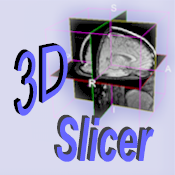Difference between revisions of "SlicerSummary"
| Line 5: | Line 5: | ||
The '''[http://www.slicer.org 3D Slicer]''' (or simply '''[http://www.slicer.org Slicer]''') software was initially developed as a joint effort between the [http://spl.harvard.edu/ Surgical Planning Lab at Brigham and Women's Hospital] and at the [http://csail.mit.edu/ MIT AI Lab]. The program has evolved into a national plattform supported by a variety of federal funding sources. This versatile research environment has resulted in a wide array of functionality, supporting a variety of medical imaging projects. | The '''[http://www.slicer.org 3D Slicer]''' (or simply '''[http://www.slicer.org Slicer]''') software was initially developed as a joint effort between the [http://spl.harvard.edu/ Surgical Planning Lab at Brigham and Women's Hospital] and at the [http://csail.mit.edu/ MIT AI Lab]. The program has evolved into a national plattform supported by a variety of federal funding sources. This versatile research environment has resulted in a wide array of functionality, supporting a variety of medical imaging projects. | ||
| − | Slicer is a "point and click" end-user application. Slicer is used as a vehicle for delivering algorithms to computer scientists, biomedical researchers and clinical investigators. Slicer is distributed under an open source license without a reciprocity requirement and without restrictions on use. For a sampling of the portfolio of applicatons, please see the [[ | + | Slicer is a "point and click" end-user application. Slicer is used as a vehicle for delivering algorithms to computer scientists, biomedical researchers and clinical investigators. Slicer is distributed under an open source license without a reciprocity requirement and without restrictions on use. For a sampling of the portfolio of applicatons, please see the [[http://www.slicer.org/pages/Slicer_Community| '''Slicer Gallery''']] page. |
Slicer is expected to evolve dynamically in architecture and implementation by drawing on the expertise and effort of the wider [http://www.na-mic.org NA-MIC], NAC, [http://www.nbirn.net/ BIRN] and [http://www.ncigt.org NCIGT] communities. The NA-MIC software engineering methodology, as applied to the problems which Slicer has historically addressed, is expected to result in a cleaner architecture that is easier for developers to support and extend. | Slicer is expected to evolve dynamically in architecture and implementation by drawing on the expertise and effort of the wider [http://www.na-mic.org NA-MIC], NAC, [http://www.nbirn.net/ BIRN] and [http://www.ncigt.org NCIGT] communities. The NA-MIC software engineering methodology, as applied to the problems which Slicer has historically addressed, is expected to result in a cleaner architecture that is easier for developers to support and extend. | ||
| Line 24: | Line 24: | ||
<br /> | <br /> | ||
| − | = Downloading Slicer = | + | == Downloading Slicer == |
Visit [http://www.slicer.org Slicer.org] to download Slicer. | Visit [http://www.slicer.org Slicer.org] to download Slicer. | ||
| − | = Slicer Mailing lists = | + | == Slicer Mailing lists == |
*'''slicer-users@bwh.harvard.edu''' | *'''slicer-users@bwh.harvard.edu''' | ||
Revision as of 20:39, 5 November 2008
Home < SlicerSummaryThis page provides a summary of Slicer's role in the NA-MIC Toolkit. To learn more about Slicer or to download Slicer, click here to visit the Slicer Website .
Description
The 3D Slicer (or simply Slicer) software was initially developed as a joint effort between the Surgical Planning Lab at Brigham and Women's Hospital and at the MIT AI Lab. The program has evolved into a national plattform supported by a variety of federal funding sources. This versatile research environment has resulted in a wide array of functionality, supporting a variety of medical imaging projects.
Slicer is a "point and click" end-user application. Slicer is used as a vehicle for delivering algorithms to computer scientists, biomedical researchers and clinical investigators. Slicer is distributed under an open source license without a reciprocity requirement and without restrictions on use. For a sampling of the portfolio of applicatons, please see the [Slicer Gallery] page.
Slicer is expected to evolve dynamically in architecture and implementation by drawing on the expertise and effort of the wider NA-MIC, NAC, BIRN and NCIGT communities. The NA-MIC software engineering methodology, as applied to the problems which Slicer has historically addressed, is expected to result in a cleaner architecture that is easier for developers to support and extend.
Major funding for Slicer was provided through a variety of federal and private funding sources, including NCRR, NIBIB, Roadmap, NCI, NSF, DOD and others.

|

|
| Slicer 2 is the released product | Slicer 3 beta was released in January 2007 |
Downloading Slicer
Visit Slicer.org to download Slicer.
Slicer Mailing lists
- slicer-users@bwh.harvard.edu
Questions about running Slicer can be sent to the Slicer User's Mailing List. Archives of slicer-users and subscription management tools are available at:
http://massmail.spl.harvard.edu/mailman/listinfo/slicer-users
- slicer-devel@bwh.harvard.edu
Slicer compilation/development questions can be sent to the Slicer Developer's Mailing List. Archives of slicer-devel and subscription management tools are available at:
http://massmail.spl.harvard.edu/mailman/listinfo/slicer-devel